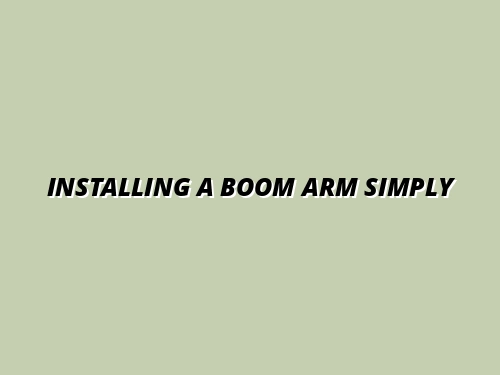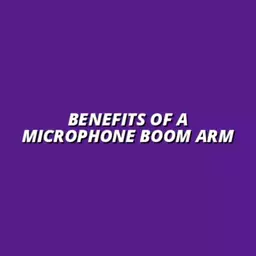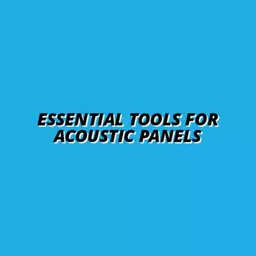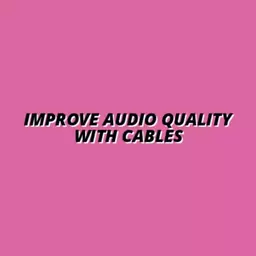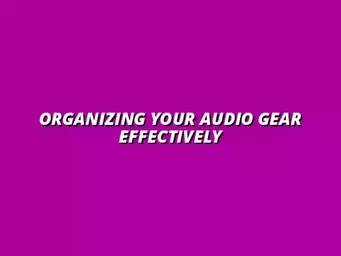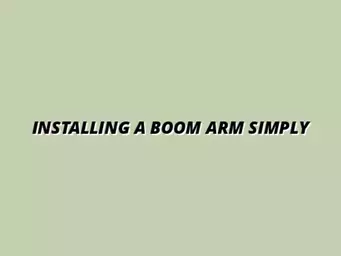When setting up your audio environment, the right tools and practices can elevate your sound quality significantly. From boom arms to cable management, each element plays a critical role in creating a professional sound. Let's explore the key insights to optimize your audio setup!
What You Will Learn
- Different types of boom arms (desk-mounted, wall-mounted, and floor-standing) can enhance your audio setup based on your space and needs.
- Effective cable management prevents interference, improves safety, and maintains a tidy workspace, crucial for focus and creativity.
- Choosing the right microphone stand (tripod, desktop, suspension) can significantly influence your recording quality and sound clarity.
- Essential equipment for a home studio includes a quality microphone, audio interface, headphones, and acoustic panels to optimize sound quality.
- Regular maintenance of boom arms and cables ensures durability and optimal performance; inspect for damage and keep them tidy.
- Acoustic treatment is vital; strategically placed panels can reduce echo and enhance sound clarity, transforming your audio experience.
Key Aspects of Audio Setup Equipment
The following visual representation highlights the essential types of audio equipment and their benefits in an audio setup.
Microphone
A quality microphone is the backbone of any setup.
Audio Interface
Allows you to connect your mic to your computer for high-quality sound input.
Headphones
A good pair of closed-back headphones helps you monitor audio without bleed.
Acoustic Panels
These enhance sound quality by reducing echo and noise.
Understanding Boom Arms and Their Importance in Audio Setup
When it comes to achieving professional-quality sound for your recordings, a boom arm is a must-have accessory. It holds your microphone in place, allowing for optimal positioning without taking up valuable desk space. As an audio enthusiast, I've often found that investing in a quality boom arm can dramatically improve both the functionality and aesthetics of your audio setup—after all, a tidy workspace is key to focus and creativity!
At Tidy Audio Desk, we understand that choosing the right boom arm can feel overwhelming due to the various types available. The right setup not only enhances your audio quality but also keeps everything organized and tidy. Let’s dive into the different types of boom arms and how they can transform your audio environment!
Defining Boom Arms: Types and Uses
Boom arms come in several different styles, each offering unique benefits depending on your setup. Here are some popular types:
- Desk-mounted boom arms: These are attached directly to your desk, providing a stable base for your microphone.
- Wall-mounted boom arms: Perfect for limited desk space, these mount to the wall and can be adjusted as needed.
- Floor-standing boom arms: These are ideal for larger setups where mobility is key, allowing you to position your mic anywhere in the room.
Each style serves its purpose—whether it's for streaming, podcasting, or professional recording, you can find a boom arm that fits your needs. Remember to consider your workspace layout and ergonomics when making your choice! If you're looking to enhance the aesthetics of your setup, you might want to consider premium boom arm sleeves.
💡 Planning an echo-free audio desk? Start with desk setup inspiration and acoustic routing. 👉 Explore the Setup Ideas Guide
Why Cable Management Matters in Audio Streaming
Have you ever struggled with tangled cables while trying to focus on your audio? Good cable management plays a crucial role in streamlining your workspace. Not only does it prevent distractions, but it also enhances the overall quality of your sound setup.
- Reduces interference: Neatly routed cables minimize the chances of electromagnetic interference, which can degrade audio quality.
- Improves safety: Organized cables lessens the risk of tripping or damaging gear.
- Enhances aesthetics: A tidy workspace not only looks professional but also fosters a creative atmosphere!
Before we delve deeper into the specifics of microphone stands, let's address some frequently asked questions about audio setup equipment:
FAQs: Audio Setup Equipment
-
What are the main types of boom arms?
Desk-mounted, wall-mounted, and floor-standing boom arms are the primary types, each suited to different space and mobility needs.
-
Why is cable management important?
Effective cable management reduces interference, improves safety, enhances aesthetics, and promotes a more focused and creative workspace.
-
What are the essential pieces of equipment for a home studio?
A quality microphone, audio interface, headphones, and acoustic panels are essential for optimizing sound quality in a home studio.
-
How do acoustic panels improve audio quality?
Acoustic panels reduce echo and noise, leading to enhanced sound clarity and a more professional audio experience.
-
How often should I maintain my boom arm and cables?
Regular inspection and maintenance, including checking for damage and keeping them tidy, ensures durability and optimal performance.
At Tidy Audio Desk, we prioritize effective cable concealment solutions, so you can focus on what matters most—your audio quality! For tips on maintaining a clean audio environment, consider these cable management tips for desks from our subdomain.
Exploring Different Microphone Stands and Their Applications
Not all microphone stands are created equal! Each type has its own strengths that can cater to different audio needs. Here are a few common options:
- Tripod stands: Great for stationary use and provide good stability.
- Desktop stands: Perfect for home studios, allowing for easy access while sitting at your desk.
- Suspension stands: Ideal for preventing noise from desk vibrations, offering a cleaner sound.
Choosing the right microphone stand not only supports your mic but also enhances your recording quality. Make sure to consider your specific audio needs to find the best match!
Essential Audio Equipment for a Home Studio
Building a home studio can be an exciting journey, but knowing what equipment to include is crucial for success. Here’s a list of essential audio gear that every home studio should have:
- Microphone: A quality microphone is the backbone of any setup.
- Audio interface: This allows you to connect your mic to your computer and ensures high-quality sound input.
- Headphones: A good pair of closed-back headphones helps you monitor audio without bleed.
- Acoustic panels: These can dramatically enhance your sound quality by reducing echo and noise.
Investing in quality equipment is essential for a polished audio experience. At Tidy Audio Desk, we encourage you to choose the right tools that will elevate your audio game—let’s make your home studio a sound sanctuary! Don't forget to consider essential acoustic gear for a studio-quality sound.
Pro Tip
Did you know? Regularly checking the tightness of screws and joints on your boom arm can significantly enhance its stability and performance. A loose boom arm can lead to unwanted shifts during recordings, which can compromise your audio quality. Make it a habit to inspect your setup every few months!
Best Practices for Maintaining Your Boom Arm and Cables
Maintaining your boom arm and cables is crucial to ensuring they last as long as possible while providing optimal performance. Just like any other gear, regular upkeep can prevent bigger issues down the line. At Tidy Audio Desk, I’ve learned that a little attention to detail goes a long way in keeping your audio setup looking and sounding great!
One of the first steps to maintaining your boom arm is to ensure cable safety and longevity. Properly managing your cables not only helps with aesthetics but also prevents wear and tear. Make sure to avoid sharp bends and excessive pulling on the cables during use. This simple habit can save you from needing costly replacements!
- Inspect cables for frays or damage regularly.
- Use cable sleeves to protect and organize your wires.
- Keep cables away from heat sources to avoid melting.
Ensuring Cable Safety and Longevity
To promote the longevity of your cables, consider investing in cable management solutions. Products like cable ties and clips not only keep your workspace tidy but also help protect your equipment from damage. Remember, every bit of organization contributes to a smoother audio experience!
Additionally, it’s essential to store your cables properly when they’re not in use. I like to coil them neatly and use cable organizers or hooks to keep them off the floor. This will keep them from getting tangled or damaged, ensuring they stay in great shape for your next recording session! For more on cable management, see these simple cable management tips.
Regular Maintenance Tips for Boom Arms
Regular maintenance for your boom arm can make all the difference in its functionality. Start by checking the tightness of screws and joints to ensure stability. A loose boom arm can lead to unwanted microphone movement, which can be quite distracting during recordings.
Don't forget to wipe down the arm with a soft cloth to remove dust and grime. This will not only keep it looking polished but also help maintain the integrity of the materials. A clean setup reflects professionalism, and at Tidy Audio Desk, we’re all about that neat appearance!
- Check screws and joints every few months.
- Use a microfiber cloth for cleaning.
- Lubricate moving parts if necessary.
Understanding the Role of Acoustic Treatment in Setup
Acoustic treatment plays a significant role in your audio quality, and it’s something that often gets overlooked. By adding acoustic panels and other treatments to your workspace, you can dramatically enhance the sound experience. It’s like giving your audio setup a performance upgrade!
Consider placing panels strategically around your microphone to minimize echoes and improve clarity. This will create a more professional sound that will impress your listeners! At Tidy Audio Desk, we believe that taking these small steps can lead to big changes in your audio projects. To help with this, check out this guide on acoustic panel placement.
- Identify areas where sound echoes significantly.
- Install acoustic panels to absorb sound.
- Experiment with placement for the best results.
Recap of Key Points
Here is a quick recap of the important points discussed in the article:
- Types of Boom Arms: Choose the right boom arm based on your setup—desk-mounted, wall-mounted, or floor-standing options are available.
- Cable Management: Proper cable management reduces interference, improves safety, and enhances the aesthetics of your workspace.
- Microphone Stands: Select the right microphone stand for your needs, whether it's a tripod, desktop, or suspension stand.
- Essential Equipment: Equip your home studio with a quality microphone, audio interface, headphones, and acoustic panels for optimal sound.
- Regular Maintenance: Inspect and maintain your boom arm and cables regularly to ensure longevity and optimal performance. Consider using cable sleeves and storing cables properly.
- Acoustic Treatment: Enhance audio quality by strategically placing acoustic panels to minimize echoes and improve sound clarity.

